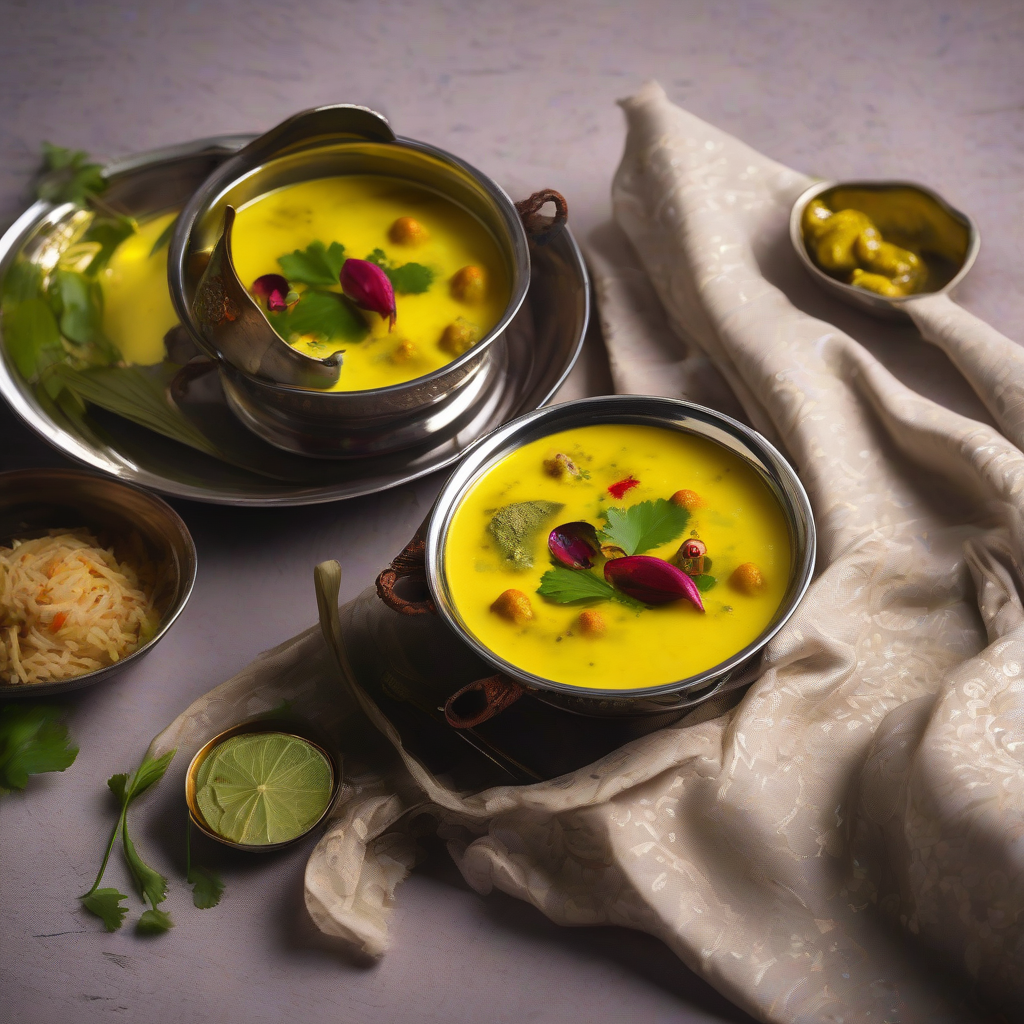Kadhi Calling, Pahari Style: A Taste of the Hills in Your Home!
Namaste doston! Sat Sri Akal! Kem cho? Chef Curry Do’pyaza here, back with a recipe that will transport you straight to the cool, crisp air of the Himalayas! Today, we’re diving deep into the creamy, tangy goodness of Pahari Kadhi, a dish so comforting, it’s like a warm hug on a chilly day.
Pahari Kadhi isn’t just food; it’s a feeling. It’s the taste of home, the aroma of tradition, and the warmth of family gatherings. In the mountainous regions of North India, especially Himachal Pradesh and Uttarakhand, this kadhi is a staple. You’ll find it gracing tables during festivals like Dussehra and Diwali, warming hearts during the long winter months, and even making a special appearance at weddings and other auspicious occasions. It’s the ultimate comfort food, perfect for those days when you need a little extra love in your bowl.
A Little Trip Down Memory Lane
Kadhi itself has ancient roots, mentioned in ancient Indian texts. Each region of India has its own unique twist. Pahari Kadhi, with its use of local ingredients and simple techniques, reflects the hardy and resourceful spirit of the people who live in the hills. It’s a testament to how delicious food can be when made with love and the freshest ingredients.
Get Ready to Cook!
Preparation Time: 15 minutes
Cooking Time: 30 minutes
What You’ll Need (Ingredients ka List)
- Besan (Gram Flour): 1/2 cup – This is the base, so make sure it’s fresh!
- Dahi (Yogurt): 2 cups, whisked smooth – Use plain, full-fat yogurt for the best flavor.
- Pani (Water): 3 cups – Adjust as needed for your desired consistency.
- Sarson ka Tel (Mustard Oil): 2 tablespoons – This gives it that authentic Pahari flavor, but you can use vegetable oil if you prefer.
- Jeera (Cumin Seeds): 1 teaspoon – Adds a warm, earthy note.
- Methi Seeds (Fenugreek Seeds): 1/2 teaspoon – Adds a slightly bitter, complex flavor.
- Rai (Mustard Seeds): 1/2 teaspoon – Gives a lovely pop of flavor.
- Heeng (Asafoetida): A pinch – This powerful spice adds a unique savory depth.
- Adrak-Lahsun Paste (Ginger-Garlic Paste): 1 tablespoon – Freshly made is always best!
- Haldi Powder (Turmeric Powder): 1/2 teaspoon – Adds color and earthy flavor.
- Lal Mirch Powder (Red Chili Powder): 1/2 teaspoon (or to taste) – For a touch of heat!
- Hara Dhaniya (Fresh Coriander Leaves): For garnish – Adds freshness and vibrancy.
- Namak (Salt): To taste
Let’s Get Cooking (Cooking ka Tareeka)
- The Base is Key: In a large bowl, whisk together the besan and yogurt until completely smooth. Add water gradually, whisking constantly to avoid any lumps. This is your kadhi base.
- Tempering Time (Tadka): Heat the mustard oil in a deep pot or kadhai over medium heat. Once the oil is hot, add the jeera, methi seeds, and rai. Let them splutter and release their aroma.
- Spice it Up: Add the heeng, ginger-garlic paste, and sauté for a minute until fragrant. Be careful not to burn the garlic!
- Color and Flavor: Add the haldi powder and lal mirch powder. Sauté for another 30 seconds.
- Bring it Together: Slowly pour the kadhi base into the pot, stirring constantly to prevent it from curdling.
- Simmer and Stir: Bring the kadhi to a gentle boil, then reduce the heat to low and simmer for at least 20-25 minutes, stirring occasionally. The longer it simmers, the thicker and more flavorful it will become.
- Season and Serve: Add salt to taste. Garnish with fresh coriander leaves. Serve hot with rice or roti.
Chef’s Tips for a Perfect Kadhi
- Whisking is Your Friend: Make sure the yogurt and besan are whisked together thoroughly to avoid lumps.
- Low and Slow: Simmering the kadhi on low heat is crucial for developing the flavors and achieving the right consistency.
- Taste and Adjust: Don’t be afraid to adjust the spices to your liking.
- Fresh is Best: Use fresh ingredients whenever possible for the best flavor.
Kadhi Your Way (Different Cooking Methods)
- Gas Stove/Induction Stove: The traditional method, perfect for simmering the kadhi slowly.
- Pressure Cooker: Not recommended, as the yogurt can curdle easily.
- Oven: Not suitable for this recipe.
- Microwave: Not recommended, as it’s difficult to control the cooking process.
- Air Fryer: Not suitable for this recipe.
- Slow Cooker/Crockpot: You can cook the kadhi in a slow cooker on low heat for 4-6 hours.
Goodness in Every Bowl (Nutritional Information – Approximate)
- Calories: 200-250 per serving
- Protein: 8-10 grams
- Carbohydrates: 20-25 grams
- Fat: 10-15 grams
(Note: These values are approximate and may vary depending on the specific ingredients and portion sizes.)
Serving Suggestions
Pahari Kadhi is traditionally served hot with steamed rice or roti. It also pairs well with:
- Jeera Rice: A simple and flavorful rice dish.
- Plain Paratha: A flaky and buttery flatbread.
- Aloo Gobi: A classic potato and cauliflower curry.
- Any Sabzi: It can be served with any dry vegetable dish.
Time to Get Cooking!
So there you have it, folks! My take on the delightful Pahari Kadhi. It’s a simple, flavorful, and comforting dish that’s sure to become a family favorite. Go ahead, give it a try! I know you’ll love it. Prepare this amazing dish for your loved ones and let them enjoy the taste of the hills in their own homes.
Happy cooking, and remember, food is love!
Your friend,
Chef Curry Do’pyaza
